Milwaukee 5378-21, 5378-20 User Manual
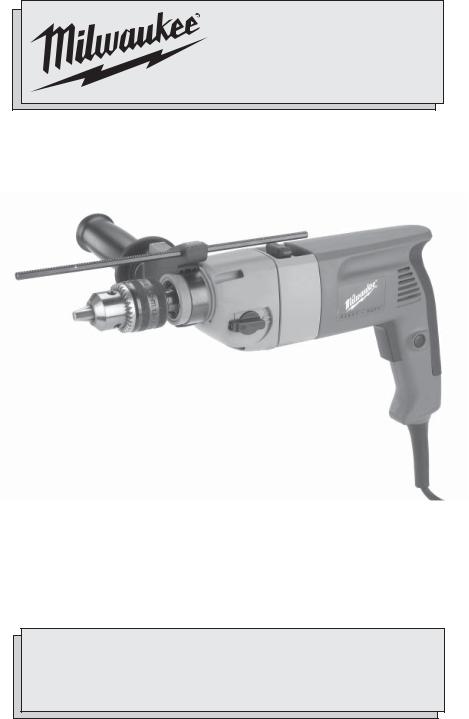
OPERATOR'S MANUAL
MANUEL de L'UTILISATEUR
MANUAL del OPERADOR
Cat. No. No de cat.
Cat. No.
5378-20
5378-21
1/2" HAMMER-DRILL
PERCEUSES À PERCUSSION 13 mm (1/2") 13 mm (1/2") TALADRO-MARTILLO
TO REDUCE THE RISK OF INJURY, USER MUST READ OPERATOR'S MANUAL.
AFIN DE RÉDUIRE LE RISQUE DE BLESSURES, L'UTILISATEUR DOIT LIRE LE MANUEL DE L'UTILISATEUR.
PARA REDUCIR EL RIESGO DE LESIONES, EL USUARIO DEBE LEER EL MANUAL DEL OPERADOR.
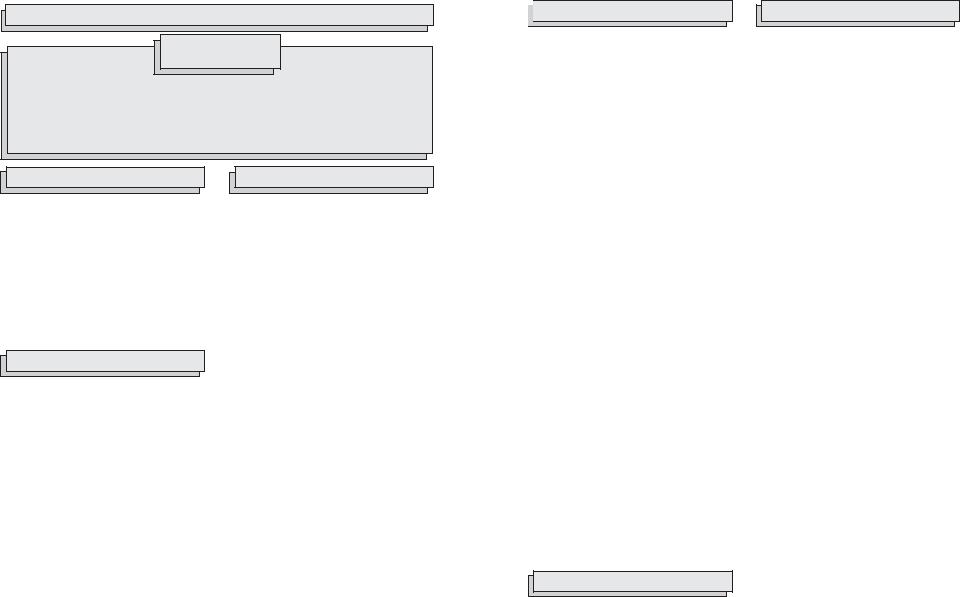
GENERAL SAFETY RULES — FOR ALL POWER TOOLS
WARNING
READ ALL INSTRUCTIONS
Failure to follow all instructions listed below may result in electric shock, fire and/or serious injury. The term "power tool" in all of the warnings listed below refers to your mains-operated (corded) power tool or battery-operated (cordless) power tool.
SAVE THESE INSTRUCTIONS
WORK AREA SAFETY
1.Keep work area clean and well lit.
Cluttered or dark areas invite accidents.
2.Do not operate power tools in explosive atmospheres, such as in the presence of flammable liquids, gases, or dust. Power tools create sparks which may ignite the dust or fumes.
3.Keep children and bystanders away while operating a power tool. Distractions can cause you to lose control.
ELECTRICAL SAFETY
PERSONAL SAFETY
9.Stay alert, watch what you are doing and use common sense when operating a power tool. Do not use a power tool while you are tired or under the influence of drugs, alcohol or medication. A moment of inattention while operating power tools may result in serious personal injury.
10.Use safety equipment. Always wear eye protection. Safety equipment such as dust mask, non-skid safety shoes, hard hat, or hearing protection used for appropriate conditions will reduce personal injuries.
4.Power tool plugs must match the outlet. Never modify the plug in any way. Do not use any adapter plugs with earthed (grounded) power tools.
Unmodified plugs and matching outlets will reduce risk of electric shock.
5.Avoid body contact with earthed or grounded surfaces such as pipes, radiators, ranges and refrigerators.
There is an increased risk of electric shock if your body is earthed or grounded.
6.Do not expose power tools to rain or wet conditions. Water entering a power tool will increase the risk of electric shock.
7.Do not abuse the cord. Never use the cord for carrying, pulling, or unplugging the power tool. Keep cord away from heat, oil, sharp edges, or moving parts. Damaged or entangled cords increase the risk of electric shock.
8.When operating a power tool outdoors, use an extension cord suitable for outdoor use. Use of a cord suitable for outdoor use reduces the risk of electric shock.
11.Avoid accidental starting. Ensure the switch is in the off-position before plugging in. Carrying tools with your finger on the switch or plugging in power tools that have the switch on invites accidents.
12.Remove any adjusting key or wrench before turning the power tool on. A wrench or a key left attached to a rotating part of the power tool may result in personal injury.
13.Do not overreach. Keep proper footing and balance at all times. This enables better control of the power tool in unexpected situations.
14.Dress properly. Do not wear loose clothing or jewellery. Keep your hair, clothing and gloves away from moving parts. Loose clothes, jewellery, or long hair can be caught in moving parts.
15.If devices are provided for the connection of dust extraction and collection facilities, ensure these are connected and properly used. Use of these devices can reduce dust-related hazards.

 POWER TOOL USE AND CARE
POWER TOOL USE AND CARE
16.Do not force the power tool. Use the correct power tool for your application. The correct power tool will do the job better and safer at the rate for which it was designed.
17.Do not use the power tool if the switch does not turn it on and off.Any power tool that cannot be controlled with the switch is dangerous and must be repaired.
18.Disconnect the plug from the power source and/or the battery pack from the power tool before making any adjustments, changing accessories, or storing power tools. Such preventive safety measures reduce the risk of starting the tool accidentally.
19.Store idle power tools out of the reach of children and do not allow persons unfamiliar with the power tools or these instructions to operate power tools. Power tools are dangerous in the hands of untrained users.
20.Maintain power tools. Check for misalignment or binding of moving parts, breakage of parts and any other condition that may affect the power tool's operation. If damaged, have the power tool repaired before use. Many accidents are caused by poorly maintained power tools.
21.Keep cutting tools sharp and clean.
Properly maintained cutting tools with sharp cutting edges are less likely to bind and are easier to control.
22.Use the power tool, accessories and tool bits etc., in accordance with these instructions and in the manner intended for the particular type of power tool, taking into account the working conditions and the work to be performed. Use of the power tool for operations different from those intended could result in a hazardous situation.
SERVICE
23.Have your power tool serviced by a qualified repair person using only identical replacement parts. This will ensure that the safety of the power tool is maintained.
SPECIFIC SAFETY RULES
1.Hold tool by insulated gripping surfaces when performing an operation where the cutting tool may contact hidden wiring or its own cord. Contact with a "live" wire will make exposed metal parts of the tool "live" and shock the operator.
2.Wear ear protectors when using the tool for extended periods. Prolonged exposure to high intensity noise can cause hearing loss.
3.Keep hands away from all cutting edges and moving parts.
4.Maintain labels and nameplates.
These carry important information. If unreadable or missing, contact a MILWAUKEE service facility for a free replacement.
5.WARNING! Some dust created by power sanding, sawing, grinding, drilling, and other construction activities contains chemicals known to cause cancer, birth defects or other reproductive harm. Some examples of these chemicals are:
•lead from lead-based paint
•crystalline silica from bricks and cement and other masonry products, and
•arsenic and chromium from chemicallytreated lumber.
Your risk from these exposures varies, depending on how often you do this type of work. To reduce your exposure to these chemicals: work in a well ventilated area, and work with approved safety equipment, such as those dust masks that are specially designed to filter out microscopic particles.
2 |
3 |
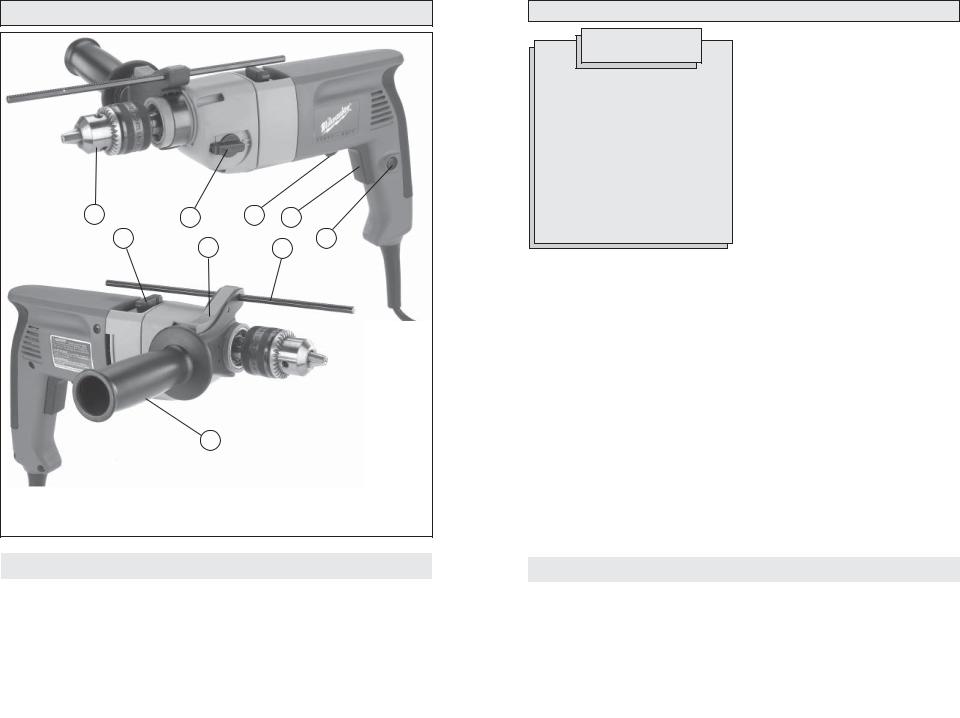
FUNCTIONAL DESCRIPTION
9 |
8 |
7 |
6 |
|
4 |
|
5 |
|
3 |
|
2 |
1. Side handle
2. Depth guage
3. Clamping lever
14. Hammer/Drill lever
5.Lock button
6.Trigger
7.Forward/Reverse lever
8.Speed selector
9.Chuck
Specifications
|
|
|
|
|
|
Capacities |
||
|
|
|
|
|
|
|
||
|
|
|
Tool |
|
Drill Only |
Rotary Hammer |
||
|
|
|
|
|
|
(steel or wood) |
(concrete) |
|
Cat. |
Volts |
|
No Load |
No Load |
Twist |
Carbide Tipped |
||
|
Blows per |
Drill |
Percussion |
|||||
No. |
AC |
A |
|
RPM |
Minute |
Bit |
Bit |
|
5378-20 |
120 |
7.5 |
Low |
0 - 1350 |
22,000 |
1/2" - 1-1/2" |
5/8" |
|
and |
||||||||
|
|
High |
0 - 2500 |
40,000 |
|
|
||
5378-21 |
|
|
|
|
||||
|
|
|
|
|
|
|
||
|
|
|
|
|
4 |
|
|
|
GROUNDING
WARNING
Improperly connecting the grounding wire can result in the risk of electric shock. Check with a qualified electrician if you are in doubt as to whether the outlet is properly grounded. Do not modify the plug provided with the tool. Never remove the grounding prong from the plug. Do not use the tool if the cord or plug is damaged. If damaged, have it repaired by a MILWAUKEE service facility before use. If the plug will not fit the outlet, have a proper outlet installed by a qualified electrician.
Grounded Tools:
Tools with Three Prong Plugs
Tools marked “Grounding Required” have a three wire cord and three prong grounding plug. The plug must be connected to a properly grounded outlet (See Figure A). If the tool should electrically malfunction or break down, grounding provides a low resistance path to carry electricity away from the user, reducing the risk of electric shock.
The grounding prong in the plug is connected through the green wire inside the cord to the grounding system in the tool. The green wire in the cord must be the only wire connected to the tool's grounding system and must never be attached to an electrically “live” terminal.
Your tool must be plugged into an appropriate outlet, properly installed and grounded in accordance with all codes and ordinances. The plug and outlet should look like those in Figure A.
Double Insulated Tools: Tools with Two Prong Plugs
Tools marked “Double Insulated” do not require grounding. They have a special double insulation system which satisfies OSHA requirements and complies with the applicable standards of Underwriters Laboratories, Inc., the Canadian Standard Association and the National Electrical Code. Double Insulated tools may be used in either of the 120 volt outlets shown in Figures B and C.
Fig. B |
Fig. C |
Symbology
|
Double Insulated |
BPM |
Blows per Minute (BPM) |
|
|
||
|
|
|
|
|
Underwriters Laboratories, Inc. |
|
Volts Alternating Current |
|
|
|
|
|
Amps |
|
No Load Revolutions per |
|
|
Minute (RPM) |
|
|
|
|
|
|
|
|
|
|
Canadian Standards |
|
Mexican Approvals Marking |
|
Association |
|
|
|
|
|
|
|
|
|
|
|
|
5 |
|
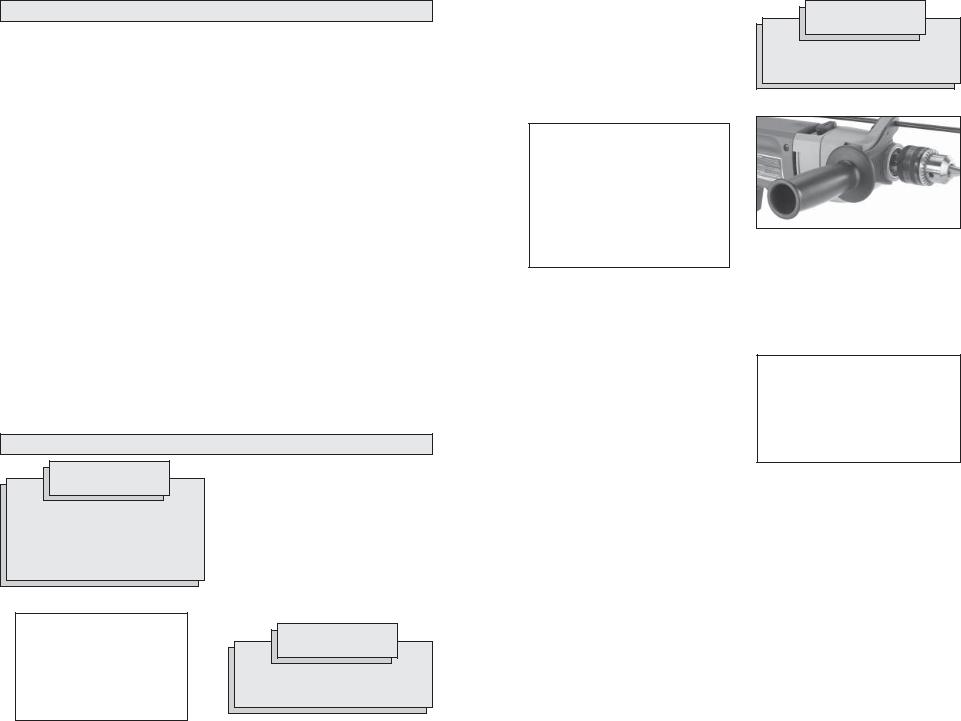
EXTENSION CORDS
Grounded tools require a three wire extension cord. Double insulated tools can use either a two or three wire extension cord. As the distance from the supply outlet increases, you must use a heavier gauge extension cord. Using extension cords with inadequately sized wire causes a serious drop in voltage, resulting in loss of power and possible tool damage. Refer to the table shown to determine the required minimum wire size.
The smaller the gauge number of the wire, the greater the capacity of the cord. For example, a 14 gauge cord can carry a higher current than a 16 gauge cord. When using more than one extension cord to make up the total length, be sure each cord contains at least the minimum wire size required. If you are using one extension cord for more than one tool, add the nameplate amperes and use the sum to determine the required minimum wire size.
Guidelines for Using Extension Cords
•If you are using an extension cord outdoors, be sure it is marked with the suffix “W-A” (“W” in Canada) to indicate that it is acceptable for outdoor use.
•Be sure your extension cord is properly wired and in good electrical condition. Always replace a damaged extension cord or have it repaired by a qualified person before using it.
•Protect your extension cords from sharp objects, excessive heat and
damp or wet areas.
Recommended Minimum Wire Gauge
for Extension Cords*
Nameplate |
Extension Cord Length |
|||||
Amperes |
25' |
50' |
75' |
100' |
150' |
|
|
|
|
|
|
|
|
0 - 2.0 |
18 |
18 |
18 |
18 |
16 |
|
2.1 |
- 3.4 |
18 |
18 |
18 |
16 |
14 |
3.5 |
- 5.0 |
18 |
18 |
16 |
14 |
12 |
5.1 |
- 7.0 |
18 |
16 |
14 |
12 |
12 |
7.1 - 12.0 |
16 |
14 |
12 |
10 |
|
|
12.1 |
- 16.0 |
14 |
12 |
10 |
|
|
16.1 |
- 20.0 |
12 |
10 |
|
|
|
|
|
|
|
|
|
|
* Based on limiting the line voltage drop to five volts at 150% of the rated amperes.
READ AND SAVE ALL INSTRUCTIONS FOR FUTURE USE.
TOOL ASSEMBLY
WARNING
To reduce the risk of injury, always unplug tool before attaching or removing accessories or making adjustments. Use only specifically recommended accessories. Others may be hazardous.
1.Open the chuck jaws fully.
2.Remove the screw inside the chuck head. This is a left hand screw, turn clockwise to remove.
3.Hold the spindle with a wrench (Fig. 1).
4.Insert the drill chuck key inside chuck and loosen clockwise by tapping lightly with a rubber hammer.
Removing the Chuck (Fig. 1)
Fig. 1
NOTE: To mount the chuck, reverse the instructions above.
WARNING
To prevent personal injury, always remove the chuck key from the chuck after each use.
Installing Bits into Keyed Chucks (Fig. 2)
Be sure that the shank of the bit and the chuck jaws are clean. Dirt particles may cause the bit to line up improperly. Do not use bits larger than the maximum recommended capacity of the drill because gear damage or motor overloading may result. For best performance, be sure that the bits are properly sharpened before use.
Fig. 2
Loosen
Tighten
1.Unplug the tool.
2.Open the chuck jaws wide enough to insert a bit. Allow the bit to strike the bottom of the chuck. Center the bit in the chuck jaws and tighten the jaws by hand to align the bit.
3.Place the chuck key into each of the three holes in the chuck, turning it clockwise to tighten the chuck securely.
NOTE: Never use a wrench or means other than a chuck key to tighten or loosen the chuck.
4.To remove the bit, insert the chuck key into one of the holes in the chuck and turn it counterclockwise.
WARNING
To reduce the risk of injury, always use a side handle when using this tool. Always brace or hold securely.
Adjusting the Side Handle Position (Fig. 3)
Fig. 3
 Side handle grip
Side handle grip
1.Loosen the side handle by unscrewing the side handle grip until the side handle rotates freely.
2.Rotate the side handle to the desired position.
3.Tighten the side handle grip securely.
Setting the Depth Gauge (Fig. 4)
Fig. 4
Drilling
Depth
1.Press in the clamping lever.
2.Slide the depth gauge rod backward or forward until it is set for the desired depth.
NOTE: The drilling depth is the distance between the tip of the bit and the tip of the depth gauge rod.
3.Release the clamping lever.
6 |
7 |
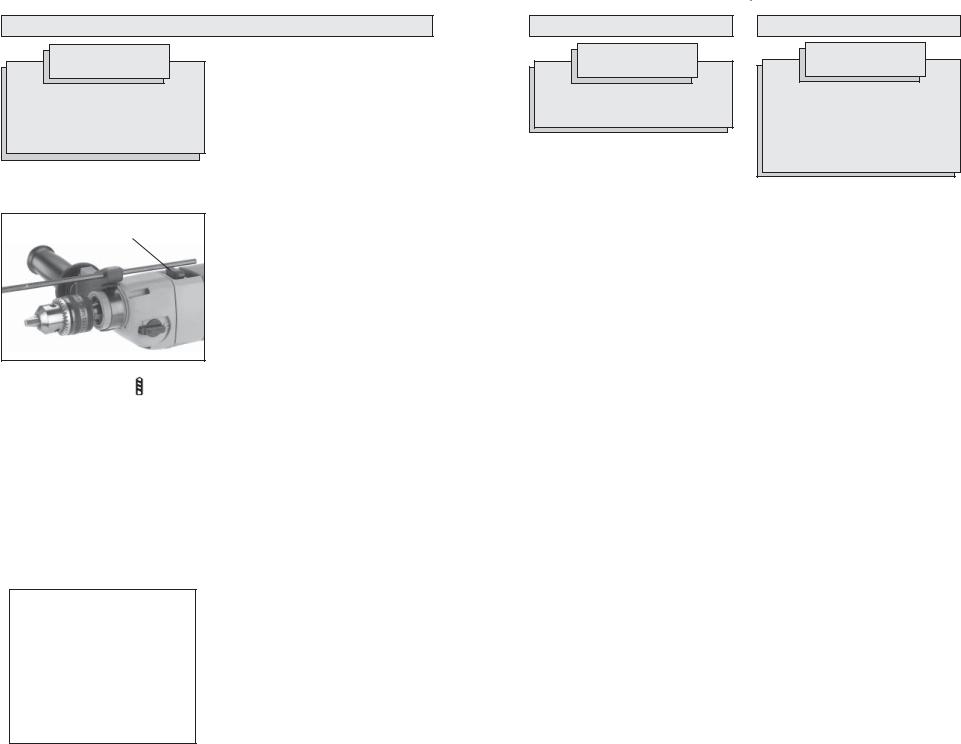
OPERATION
 WARNING
WARNING
To reduce the risk of injury, wear safety goggles or glasses with side shields. Unplug the tool before changing accessories or making adjustments.
Selecting Action (Fig. 5)
MILWAUKEE Hammer-Drills have two settings: drilling and hammer-drilling.
Fig. 5
Selector Lever
1.For drilling, turn the hammer-drill lever
towards the drill symbol .
2.For hammer-drilling, turn the
hammer-drill lever towards the hammer symbol  .
.
NOTE: To engage the hammering mechanism, maintain pressure on the bit. When pressure on the bit is released, the hammering action will stop.
Using Forward/Reverse Lever (Fig. 6)
The forward/reverse lever can only be adjusted when the trigger is not pressed. Always allow the motor to come to a complete stop before using the forward/reverse lever.
Fig. 6
Forward
1.For forward (clockwise) rotation, push the forward/reverse lever to the left (when viewed from the back of the tool) as shown.
2.For reverse (counterclockwise) rotation, push the forward/reverse lever to the right (when viewed from the back of the tool) as shown. Allow the motor to come to a full stop before reversing.
NOTE: When hammer-drilling, use the tool in forward rotation (clockwise) only.
Selecting Speed
The speed can be changed when the tool is at a complete stop or running under no load.
1.For low speed (up to 1350 rpm), turn the speed selector to position 1.
2.For high speed (up to 2500 rpm), turn the speed selector to position 2.
Starting, Stopping & Controlling Speed
1.To start the tool, pull trigger.
2.To stop the tool, release trigger.
3.To vary the speed, increase or decrease pressure to trigger. The further the trigger is pulled, the greater the speed.
Operating
Position the tool, grasp the handles firmly and pull the trigger. Always hold the tool securely using both handles and maintain control. This tool has been designed to achieve top performance with only moderate pressure. Let the tool do the work.
If the speed begins to drop off when drilling deep holes, pull the bit partially out of the hole while the tool is running to help clear dust. Do not use water to settle the dust since it will clog the bit flutes and tend to make the bit bind in the hole.
Reverse
8
APPLICATIONS
 WARNING
WARNING
To reduce the risk of electric shock, check work area for hidden pipes and wires before drilling.
Drilling in Wood, Composition Materials and Plastic
When drilling in wood, composition materials and plastic, select the drill operating mode. Start the drill slowly, gradually increasing speed as you drill. Select low speeds for plastics with a low melting point.
Drilling in Metal
When drilling in metal, select the drill operating mode. Use high speed steel twist drills or hole saws. Use a center punch to start the hole. Lubricate drill bits with cutting oil when drilling in iron or steel. Use a coolant when drilling in nonferrous metals such as copper, brass or aluminum. Back the material to prevent binding and distortion on breakthrough.
Drilling in Masonry
When drilling in masonry, select the ham- mer-drill operating mode. Use high speed carbide-tipped bits. Drilling soft masonry materials such as cinder block requires little pressure. Hard materials like concrete require more pressure. A smooth, even flow of dust indicates the proper drilling rate. Do not let the bit spin in the hole without cutting. Do not use water to settle dust or to cool bit. Do not attempt to drill through steel reinforcing rods. Both actions will damage the carbide.
MAINTENANCE
WARNING
Toreducetheriskofinjury,alwaysunplug your tool before performing any maintenance.Neverdisassemblethe tool or try to do any rewiring on the tool's electrical system. Contact a MILWAUKEE service facility for ALL repairs.
Maintaining Tools
Keep your tool in good repair by adopting a regular maintenance program. Before use, examine the general condition of your tool. Inspect guards, switches, tool cord set and extension cord for damage. Check for loose screws, misalignment, binding of moving parts, improper mounting, broken parts and any other condition that may affect its safe operation. If abnormal noise or vibration occurs, turn the tool off immediately and have the problem corrected before further use. Do not use a damaged tool. Tag damaged tools “DO NOT USE” until repaired (see “Repairs”).
Under normal conditions, relubrication is not necessary until the motor brushes need to be replaced. After six months to one year, depending on use, return your tool to the nearest MILWAUKEE service facility for the following:
•Lubrication
•Brush inspection and replacement
•Mechanical inspection and cleaning (gears, spindles, bearings, housing, etc.)
•Electrical inspection (switch, cord, armature, etc.)
•Testing to assure proper mechanical and electrical operation
9
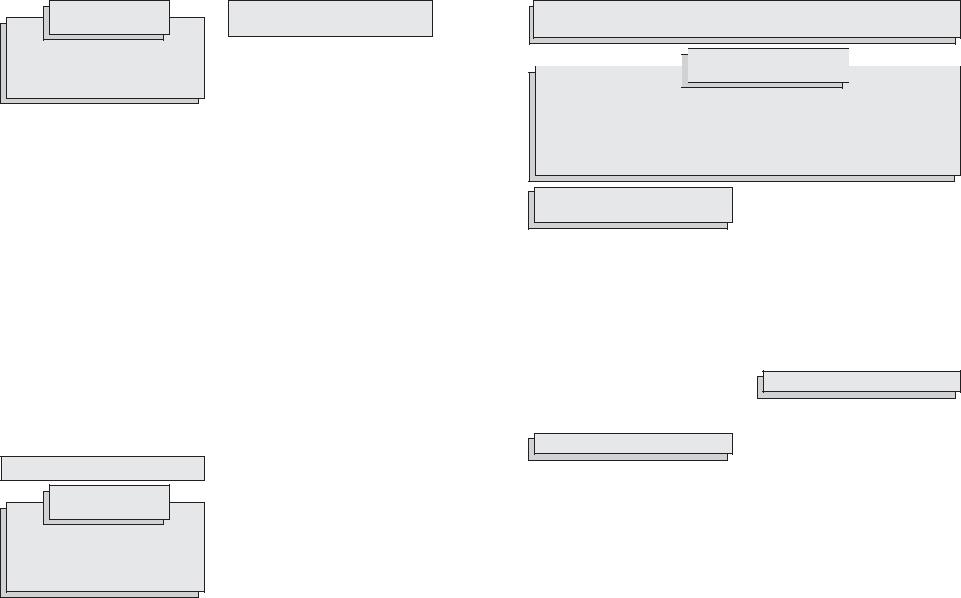
WARNING
To reduce the risk of injury, electric shock and damage to the tool, never immerse your tool in liquid or allow a liquid to flow inside the tool.
Cleaning
Clean dust and debris from vents. Keep the tool handles clean, dry and free of oil or grease. Use only mild soap and a damp cloth to clean your tool since certain cleaning agents and solvents are harmful to plastics and other insulated parts. Some of these include: gasoline, turpentine, lacquer thinner, paint thinner, chlorinated cleaning solvents, ammonia and household detergents containing ammonia. Never use flammable or combustible solvents around tools.
Repairs
If your tool is damaged, return the entire tool to the nearest service center.
ACCESSORIES
WARNING
To reduce the risk of injury, always unplug the tool before attaching or removing accessories. Use only specifically recommended accessories. Others may be hazardous.
For a complete listing of accessories refer to your MILWAUKEE Electric Tool catalog or go on-line to www.milwaukeetool.com. To obtain a catalog, contact your local distributor or a service center.
Side Handle
Cat. No. 49-15-5300
FIVE YEAR TOOL
LIMITED WARRANTY
Every MILWAUKEE tool is tested before leaving the factory and is warranted to be free from defects in material and workmanship. MILWAUKEE will repair or replace (at MILWAUKEE’s discretion), without charge, any tool (including battery chargers) which examination proves to be defective in material or workmanship from five (5) years after the date of purchase. Return the tool and a copy of the purchase receipt or other proof of purchase to a MILWAUKEE Factory Service/Sales Support Branch location or MILWAUKEE Authorized Service Station, freight prepaid and insured. This warranty does not cover damage from repairs made or attempted by other than MILWAUKEE authorized personnel, abuse, normal wear and tear, lack of maintenance, or accidents.
The warranty period for V28 Battery Packs is two (2) years from the date of purchase. The warranty period for Ni-Cd battery Packs, Flashlights, Radios are warranted for one (1) year from the date of purchase.
THE REPAIR AND REPLACEMENT REMEDIES DESCRIBED HEREIN ARE EXCLUSIVE. IN NO EVENT SHALL MILWAUKEE BE LIABLE FOR ANY INCIDENTAL, SPECIAL, OR CONSEQUENTIAL DAMAGES, INCLUDING LOSS OF PROFITS.
THIS WARRANTY IS EXCLUSIVE AND IN LIEU OF ALL OTHER WARRANTIES, OR
CONDITIONS, WRITTEN OR ORAL, EXPRESSED OR IMPLIED FOR MERCHANTABLILITY OR FITNESS FOR PARTICULAR USE OR PURPOSE.
This warranty gives you specific legal rights. You may also have other rights that vary from state to state and province to province. In those states that do not allow the exclusion of implied warranties or limitation of incidental or consequential damages, the above limitations or exclusions may not apply to you. This warranty applies to the United States, Canada, and Mexico only.
RÈGLES GÉNÉRALES DE SÉCURITÉ POUR
LES OUTILS ÉLECTRIQUE


 AVERTISSEMENT
AVERTISSEMENT 
LIRE SOIGNEUSEMENT TOUTES LES INSTRUCTIONS
Le non respect des instructions ci-après peut entraîner des chocs électriques, des incendies et/ou des blessures graves. Le terme «outil électrique» figurant dans les avertissements ci-dessous renvoie à l’outil électrique à alimentation par le réseau (à cordon) ou par batterie (sans fil).
CONSERVER CES INSTRUCTIONS
SÉCURITÉ DU LIEU
DE TRAVAIL
1.Maintenirlazonedetravailpropreetbien éclairée. Les zones encombrées ou mal éclairées sont favorables aux accidents.
2.Ne pas utiliser d’outil électrique dans une atmosphère explosive, telle qu’en en présence de liquides, de gaz ou de poussières inflammables.
Les outils électriques génèrent des étincelles qui peuvent enflammer les poussières ou les fumées.
3.Tenir les enfants et les personnes non autorisées à l’écart pendant le fonctionnement d’un outil électrique.
Unmanqued’attentiondel’opérateurrisque de lui faire perdre le contrôle de l’outil.
SÉCURITÉ ÉLECTRIQUE
4.La fiche de l’outil électrique doit correspondre à la prise d’alimentation. Ne jamais modifier la fiche d’une manière quelconque. Ne pas utiliser d’adaptateur avec les outils électriques mis à la terre (à la masse).
Des fiches non modifiées et des prises d’alimentation assorties réduisent le risque de choc électrique.
5.Éviter tout contact corporel avec des surfaces reliées à la masse ou à la terre telles que tuyaux, radiateurs, cuisinières et réfrigérateurs. Un risque de choc électrique plus élevé existe si le corps est relié à la masse ou à la terre.
6.Ne pas exposer les outils électriques à la pluie ou à l’humidité. Le risque de choc électrique augmente si de l’eau s’infiltre dans un outil électrique.
7.Prendre soin du cordon. Ne jamais utiliser le cordon pour transporter, tirer ou débrancher l’outil électrique. Tenir le cordon à l’écart de la chaleur, des huiles, des arêtes coupantes ou des pièces en mouvement. Un cordon endommagé ou emmêlé présente un risque accru de choc électrique.
8.Se procurer un cordon d’alimentation approprié en cas d’utilisation d’un outil électrique à l’extérieur.
L’utilisation d’un cordon d’alimentation pour usage extérieur réduit le risque de choc électrique.
SÉCURITÉ INDIVIDUELLE
9.Être sur ses gardes, être attentif et faire preuve de bon sens en utilisant un outil électrique. Ne pas utiliser un outil électrique en cas de fatigue ou sous l’influence de drogues, d’alcool ou de médicaments. Un instant d’inattention lors de l’utilisation d’un outil électrique peut entraîner des blessures graves.
10.Utiliser un équipement de sécurité. Toujours porter des lunettes de protection. Un équipement de sécurité comprenant masque anti-poussière, chaussures de sécurité anti-dérapantes, casque ou dispositif de protection antibruit peut, dans les circonstances appropriées, réduire le risque de blessure.
11.Éviter tout démarrage accidentel de l’outil. S’assurer que le commutateur est en position OFF (Arrêt) avant de brancher l’outil. Le port de l’outil avec un doigt sur le commutateur ou son branchement avec le commutateur en position ON (Marche) sont favorables aux accidents.
10 |
11 |
